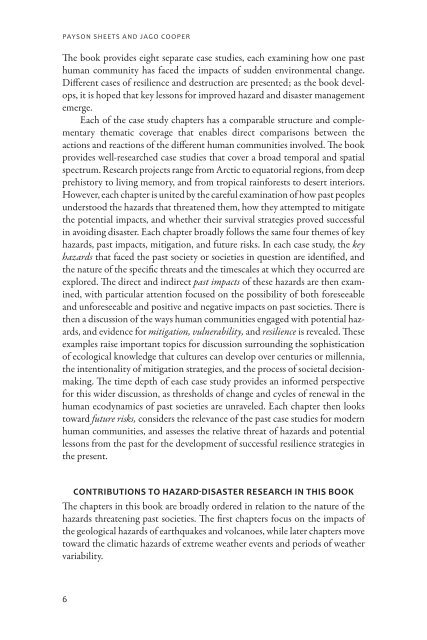free download - University Press of Colorado
free download - University Press of Colorado
free download - University Press of Colorado
You also want an ePaper? Increase the reach of your titles
YUMPU automatically turns print PDFs into web optimized ePapers that Google loves.
Payson Sheets and Jago Cooper<br />
The book provides eight separate case studies, each examining how one past<br />
human community has faced the impacts <strong>of</strong> sudden environmental change.<br />
Different cases <strong>of</strong> resilience and destruction are presented; as the book develops,<br />
it is hoped that key lessons for improved hazard and disaster management<br />
emerge.<br />
Each <strong>of</strong> the case study chapters has a comparable structure and complementary<br />
thematic coverage that enables direct comparisons between the<br />
actions and reactions <strong>of</strong> the different human communities involved. The book<br />
provides well-researched case studies that cover a broad temporal and spatial<br />
spectrum. Research projects range from Arctic to equatorial regions, from deep<br />
prehistory to living memory, and from tropical rainforests to desert interiors.<br />
However, each chapter is united by the careful examination <strong>of</strong> how past peoples<br />
understood the hazards that threatened them, how they attempted to mitigate<br />
the potential impacts, and whether their survival strategies proved successful<br />
in avoiding disaster. Each chapter broadly follows the same four themes <strong>of</strong> key<br />
hazards, past impacts, mitigation, and future risks. In each case study, the key<br />
hazards that faced the past society or societies in question are identified, and<br />
the nature <strong>of</strong> the specific threats and the timescales at which they occurred are<br />
explored. The direct and indirect past impacts <strong>of</strong> these hazards are then examined,<br />
with particular attention focused on the possibility <strong>of</strong> both foreseeable<br />
and unforeseeable and positive and negative impacts on past societies. There is<br />
then a discussion <strong>of</strong> the ways human communities engaged with potential hazards,<br />
and evidence for mitigation, vulnerability, and resilience is revealed. These<br />
examples raise important topics for discussion surrounding the sophistication<br />
<strong>of</strong> ecological knowledge that cultures can develop over centuries or millennia,<br />
the intentionality <strong>of</strong> mitigation strategies, and the process <strong>of</strong> societal decisionmaking.<br />
The time depth <strong>of</strong> each case study provides an informed perspective<br />
for this wider discussion, as thresholds <strong>of</strong> change and cycles <strong>of</strong> renewal in the<br />
human ecodynamics <strong>of</strong> past societies are unraveled. Each chapter then looks<br />
toward future risks, considers the relevance <strong>of</strong> the past case studies for modern<br />
human communities, and assesses the relative threat <strong>of</strong> hazards and potential<br />
lessons from the past for the development <strong>of</strong> successful resilience strategies in<br />
the present.<br />
Contributions to Hazard-Disaster Research in This Book<br />
The chapters in this book are broadly ordered in relation to the nature <strong>of</strong> the<br />
hazards threatening past societies. The first chapters focus on the impacts <strong>of</strong><br />
the geological hazards <strong>of</strong> earthquakes and volcanoes, while later chapters move<br />
toward the climatic hazards <strong>of</strong> extreme weather events and periods <strong>of</strong> weather<br />
variability.<br />
6





